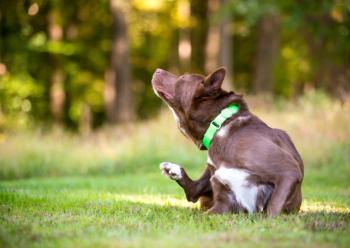
Canine and feline cryptosporidiosis and giardiasis (Proceedings)
Although humans make pets out of almost any type of animal, dogs and cats are the only domestic animal that still routinely shares the house with their owners. Thus, it is imperative to know whether or not the parasites carried by these pets are zoonotic.
Although humans make pets out of almost any type of animal, dogs and cats are the only domestic animal that still routinely shares the house with their owners. Thus, it is imperative to know whether or not the parasites carried by these pets are zoonotic. For years, the species of Cryptosporidium thought to occur in most mammalian hosts was C. parvum. Likewise, the species of Giardia thought most common was G. duodenalis (also called G. lamblia and G. intestinalis). Because these species occurred in humans and other mammals, they were both considered to be zoonotic. However, current evidence indicates that this dogma was incorrect. We now know that dogs and cats do not routinely share either parasite with their healthy human companions. Dogs are hosts for Cryptosporidium canis and cats are hosts for Cryptosporidium felis. Giardia duodenalis assemblages C and D are found in dogs while assemblage F is common in cats. Assemblage type AI, which also occurs in people, does sometimes occur in dogs and cats. However, type AII is the more common assemblage A type found in people. Occasionally, C. canis and C. felis have been documented in severely immunocompromised individuals and malnourished children, resulting in clinical disease. Thus, pet owners need to make sure they practice good sanitation to minimize environmental contamination and limit contact they and others will have with the infectious organism left behind by their pet.
Cryptosporidiosis in dogs and cats is similar. At about 5 µm, the round oocysts are quite small. They are fully infectious when passed in the feces. Infection of the next host occurs through ingestion of contaminated water, food or other contaminated environments. The oocysts exist and the sporozoites penetrate epithelial cells of the small intestine. In most cases, epithelial damage is minimal. However, in severe cases, infections result in an inability to maintain water balance. Thus, diarrhea is usually the most commonly reported clinical sign associated with infection. However, many animals are infected without showing signs at all. Detection of these small oocysts can be problematic. Oocysts can be found on fecal flotation, but, the microscopist must be aware of what he/she is looking for as they are easily overlooked. Oocysts are acid-fast positive, so staining of fecal smears can be helpful. However, because smears use such a small amount of material, numerous organisms must be present in order to be detectable. Other methods of detecting the oocysts include immunofluorescent antibody (IFA) tests and antigen detection tests. These latter tests are used for and approved in the diagnosis of human cryptosporidiosis; their utility in detecting oocysts in dogs and cats has only been verified for IFA. Oocysts are moderately resistant to environmental extremes and the routine levels of chlorine found in water. There is no approved treatment for either species of Cryptosporidium in dogs or cat.
Giardia cysts are oval in shape and approximately 10 µm in length. Trophozoites are pear-shaped, 9-21 × 5-15 µm in size, and bilaterally symmetrical with a concave adhesive disc on the ventral surface. Two nuclei and 4 pairs of flagella are present. Although trophozoites can be present in feces, particularly if diarrheic, the cyst is the environmentally resistant stage that is primarily responsible for transmission. Infection occurs through ingestion of the cyst in contaminated water, food or other contaminated environments; trophozites excyst in the small intestine where they replicate by longitudinal binary fission. Cyst formation, then, occurs as parasites transit the colon and can be found in the feces in about 5-7 days of infection.
As with Cryptosporidium, the most common clinical sign is diarrhea. However, animals can be infected without any clinical signs for months or years. Other animals may have bouts of diarrhea followed by quiescent periods. Other animals will have chronic diarrhea which lasts until the parasites are eliminated.
Although the cysts of Giardia are larger than the oocysts of Cryptosporidium, their detection is no less problematic. Cysts and trophozoites can be detected on wet mounts. Lugol's iodine can be used to stain the organisms, enhancing visualization but the iodine kills the trophozotes eliminating motility. As described for Cryptosporidium, smears are an inefficient method of detecting organisms. Other methods of detection include centrifugal fecal flotation, IFA and an immunochromatographic test that detects antigen in the feces. Treatments of choice include metronidazole and/or fenbendazole. Bathing dogs after treatment helps prevent reinfection.
Newsletter
From exam room tips to practice management insights, get trusted veterinary news delivered straight to your inbox—subscribe to dvm360.






